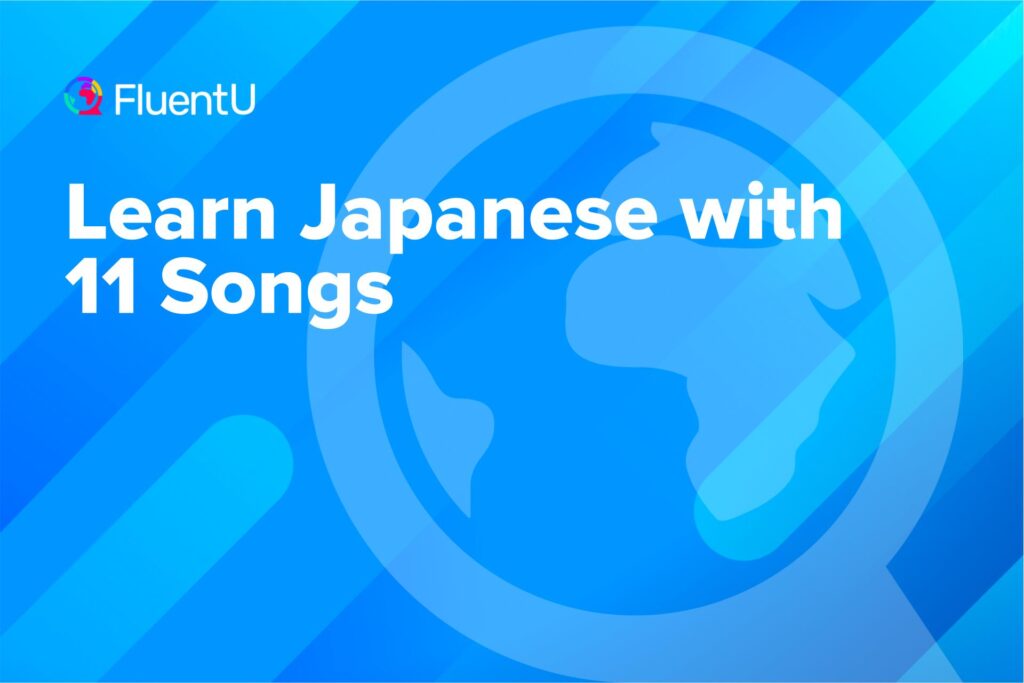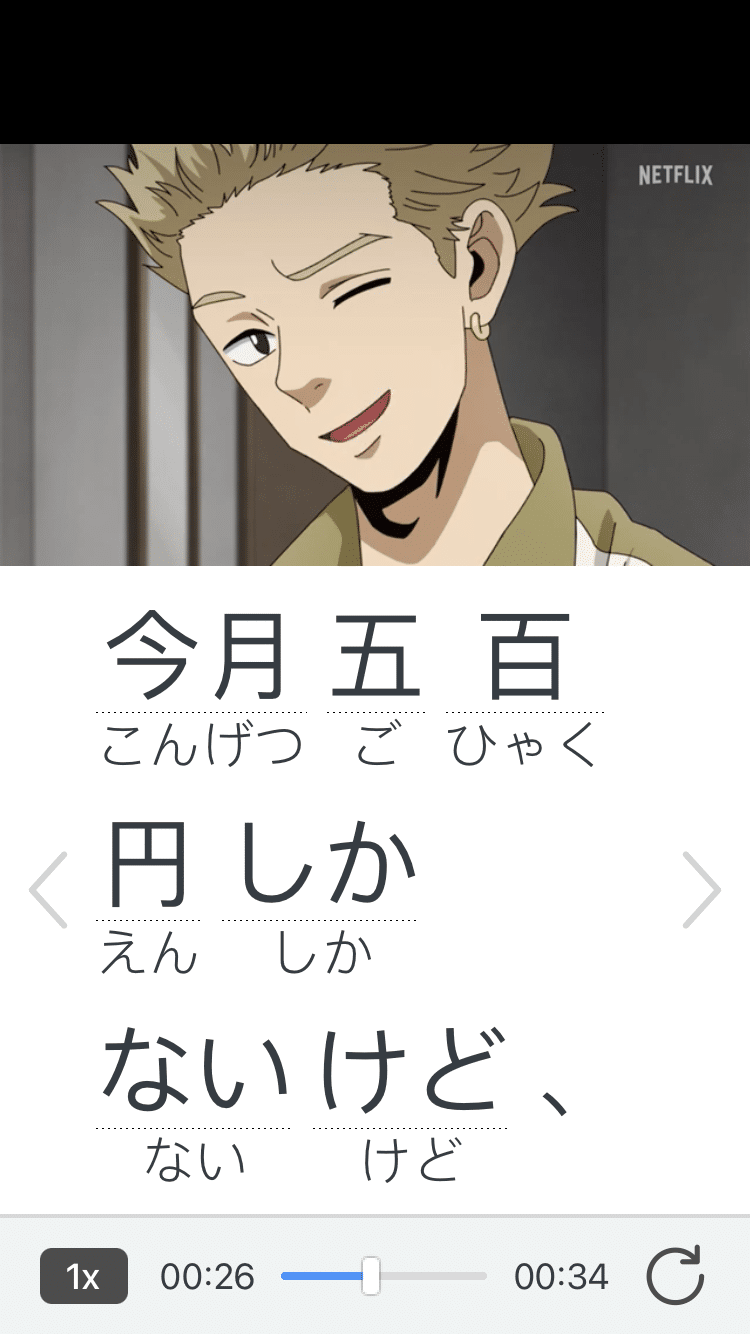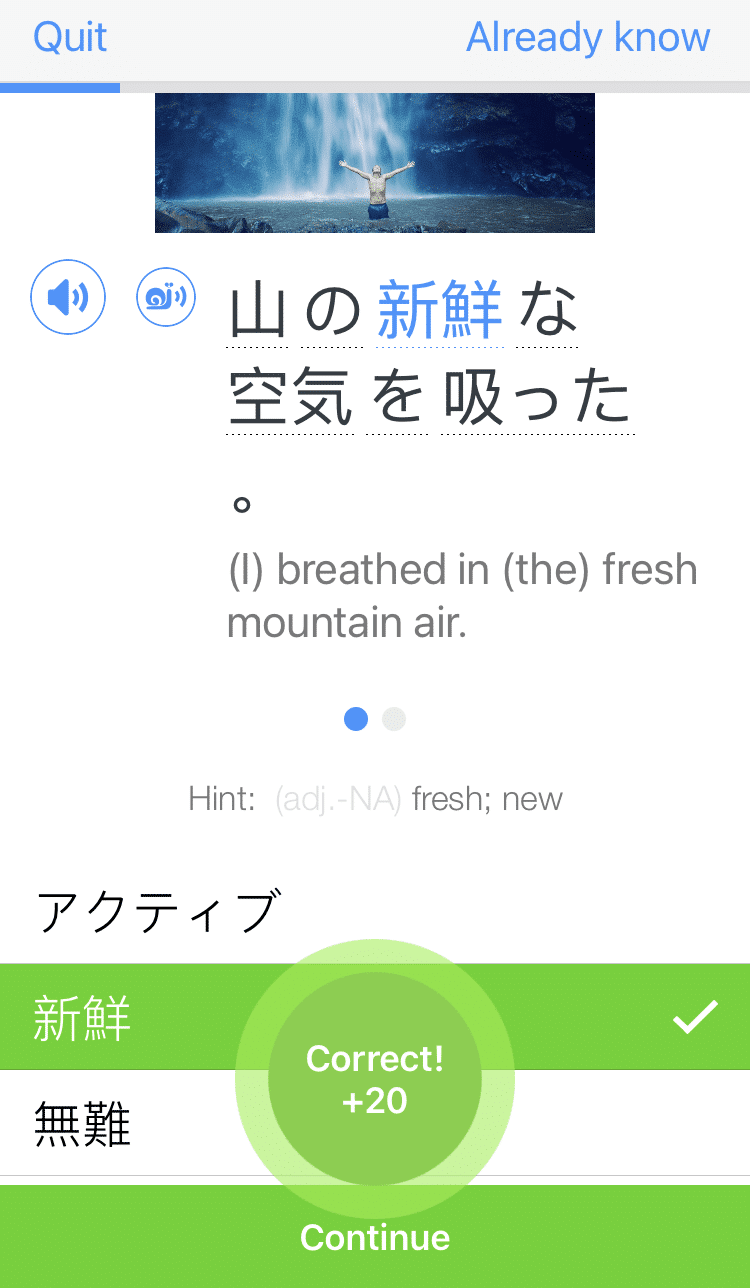Contents
- 1. “AIUEO Song”
- 2. “Learn Japanese Vocabulary with Songs!” by Wordpie
- 3. “Song for Learning Japanese” by Mihara Keigo
- 4. “My First and Last Love” by Akiko Kobayashi
- 5. “Handyman” by Perfume
- 6. “The Day They Became Gems” by Bump of Chicken
- 7. “Like the Flow of the River” by Hibari Misora
- 8. “The Only Flower in the World” by SMAP
- 9. “Koisuru Fortune Cookie” by AKB48
- 10. “Makenaide” by ZARD
- 11. “Linda Linda” by The Blue Hearts
- Popular Japanese Artists by Genre
- Helpful Techniques for Listening to Japanese
- How to Learn Japanese Songs: A 5-Step Recipe for Success
- And One More Thing...
Learn Japanese with 11 Songs

Knowing Japanese songs won’t only keep you in the loop with celebrity gossip and references in Japanese media.
They can also help you increase your vocabulary and improve your pronunciation.
In this post, you’ll learn 11 Japanese songs to get you started in your learning journey.
Download: This blog post is available as a convenient and portable PDF that you can take anywhere. Click here to get a copy. (Download)
1. “AIUEO Song”
Good for: Beginner learners
Mastering Japanese starts with the basics: hiragana and katakana.
Just like the English ABC song, “あいうえおの歌” takes you through each syllable as colorful hiragana flashes across the screen. Set to a catchy drumbeat, you might find yourself dancing as you learn hiragana.
There’s also a katakana version available and a combo version, which combines both hiragana and katakana.
This song offers an entertaining and memorable way for beginners to master Japanese fundamentals.
2. “Learn Japanese Vocabulary with Songs!” by Wordpie
Good for: Beginner learners
Wordpie is a language learning tool designed specifically to help you pick up new vocabulary by associating words with pictures and music. Vocabulary words are sung to a catchy tune as pictures of objects and written words are shown on screen.
“Learn Japanese Vocabulary with Songs!” contains 100 useful words in various categories such as weather and furniture, as well as words to describe things outside, such as “grass,” “river” and “sun.” Unlike, say, a huge stack of flashcards, this is a great tool for learning a ton of new Japanese words without getting overwhelmed or bored.
3. “Song for Learning Japanese” by Mihara Keigo
Good for: Beginner learners
With enthusiasm at its finest, learn useful phrases in Japanese as Mihara Keigo dances around, motivating you like a pep squad leader.
Learn expressions for when you’re angry or sad, how to address yourself and much more with hiragana syllables weaved in between.
You might even get up and dance to this one, too.
4. “My First and Last Love” by Akiko Kobayashi
Good for: Upper beginner to intermediate learners
If you have to profess your undying love to someone, this song may help you. Learn terms of endearment set to the backdrop of the Chinese television drama “My Sunshine.”
With lyrics written in kanji, romaji and English, this is a great song that helps you understand the subtleties of the Japanese language. Often with songs, you can’t translate lyrics word for word—so as you read the lyrics to this song, you’ll learn how to form more abstract concepts in Japanese.
A bonus is that there are some English lyrics mixed in, which makes this song relatively easy, even for beginners.
5. “Handyman” by Perfume
Good for: Upper beginner to intermediate learners
The pop band Perfume sings of romantic uncertainty and insecurity in the catchy tune “Handyman.”
In a sense, this song discusses looking for a “handyman” to help fix the problems of the relationship.
6. “The Day They Became Gems” by Bump of Chicken
Good for: Intermediate learners
If you’re looking for something a little more challenging, sing along as the popular Japanese band Bump of Chicken uses plenty of compound verbs and lightning-related vocab. The lyrics to this song rush by quickly, but the pronunciation is clear and easy to follow.
7. “Like the Flow of the River” by Hibari Misora
Good for: Intermediate learners
This was the last single Misora, a legendary enka singer, released before her death.
It has come to symbolize not only her life, but the ever-changing nature of things: The only thing that is permanent is the fact that nothing is permanent at all.
Practically a national anthem in Japan, “Kawa no nagare no you ni” is still performed frequently on TV by acts paying tribute to Misora.
8. “The Only Flower in the World” by SMAP
Good for: Upper beginner to intermediate learners
Boy band SMAP are hardly boys anymore—all of its members are pushing 40—but they remain hugely popular in Japan.
This 2004 smash is one of their most beloved songs, and has become something of a Japanese standard—in fact, even kindergarteners learn it in school.
SMAP members are not known for their vocal talents, so “Seka ni hitotsu dake no hana,” like most of their songs, is a mid-tempo, mid-range number that’s not too difficult to sing.
9. “Koisuru Fortune Cookie” by AKB48
Good for: Upper beginner to intermediate learners
Ubiquitous aidoru (idol) group AKB48 have had one hit after another since they broke out in 2008, but this 2013 single is arguably their most popular.
Its upbeat, singsong melody is easy to follow and the lyrics are fairly basic, which has helped the song cross generations: Kids and seniors alike adore it.
10. “Makenaide” by ZARD
Good for: Intermediate learners
Makenaide literally means “don’t lose” or “don’t give up.” So it’s no wonder that it has become a sports anthem, often played during events, pre-game shows, highlight reels and the like.
This inspirational number is basically the Japanese equivalent of Journey’s “Don’t Stop Believing.”
Everyone gets on their feet and belts out the words to its catchy chorus. This is a number that’s guaranteed to get everyone singing along with you at karaoke.
11. “Linda Linda” by The Blue Hearts
Good for: Intermediate learners
“Linda Linda” is a stone-cold karaoke classic. Go to karaoke with a group of Japanese friends, and there’s about a 70% chance somebody will sing it—unless you sing it first, of course.
It’s a pretty fast-paced rock song, so it’s not that easy to follow—but it’s great fun to belt out at the top of your register. Try this one when you want to get everyone jumping and pumping their fists.
Popular Japanese Artists by Genre
Think of this as less of a comprehensive list and more of a “taster” of each genre. Also, as a disclaimer, the artists listed may fall into more than one category. Artists were also chosen based on the availability of the lyrics. But use this opportunity to expand your Japanese musical repertoire, and have fun.
Pop
- きゃりーぱみゅぱみゅ (Kyary pamyu pamyu): This artist churns out incredibly catchy, mostly-nonsensical bubblegum smash hits designed to appeal to a wide audience.
- ユイ (ゆい – Yui): Yui’s pop/rock sound and ballads are tied together with her very likable voice.
- 赤西仁 (あかにし じん – Jin Akanishi): An erstwhile member of the boy band KAT-TUN gone solo, this one’s got a pop/R&B sound that has endeared him to fans over the years.
Punk
- ザ・スターリン (ざ・すたーりん – The Stalin): These guys are pretty hardcore—lots of punk grit in there to keep you occupied.
- ザ・スタークラブ (ざ・すたーくらぶ – The Star Club): This band is a very well-known punk rock group from the late 70s to 80s—fun, dirty and a whole lotta punk.
- 少年ナイフ (しょうねん ないふ – Shonen Knife): Often referred to as Japan’s female Ramones, these girls from Osaka are a super-fun pop punk, alternative band that you might just fall in love with.
Jazz
- ピチカート・ファイヴ (ぴちかーと・ふぁいゔ – Pizzicato Five): Quite popular in the 90’s, these guys will make you want to groove out.
- 東京事変 (とうきょう じへん – Tokyo Incidents): The immensely talented Sheena Ringo’s voice is just so cool—not to mention the complex musical composition, jazzy drumming and a touch of indie makes them a joy to listen to.
- ヌジャベス (ぬじゃべす – Nujabes): The late, great Nujabes (or Seba Jun) produced mostly R&B beats, but I think his sound fits the jazzy bill just fine.
Indie
- サカナクション (さかなくしょん – Sakanaction): Sakanaction is a five-piece indie/alt-rock/electronic mishmash of interesting sounds.
- ザ・ピロウズ (ざ・ぴろうず – The Pillows): Nostalgic, pleasant and wonderful, The Pillows have your perfect grooves for relaxation time.
- アジアン カンフー ジェネレーション (あじあん かんふー じぇねれーしょん – Asian Kung-Fu Generation): Now, these guys are a lot of fun—smooth and hard vocals, pleasing composition, an occasionally Weezer-ish vibe and great lyrics.
Rock/Metal
- ギターウルフ (ぎたー うるふ – Guitar Wolf): With their loud, distorted and shout-y goodness, this still-active band will have you shouting along.
- セックスマシンガンズ (せっくす ましんがんず – Sex Machineguns): The vocals have got a hair metal feel at times and the drum changes can’t be beat, making for good-ol’-fashioned moshing music.
- マキシマム ザ ホルモン (まきしまむ ざ ほるもん – Maximum the Hormone): This kickass group with a female drummer can span pop/metal/alternative/rock/rap-metal in a single song.
Alternative
- ゆらゆら帝国 (ゆらゆらていこく – Yura Yura Teikoku): I’d describe this as quirky, punchy, psychedelic-like rock, and the vocalist has a cool, relaxed sort of sound.
- ポリシックス (ぽりしっくす – Polysics): Think Rock Lobster by the B52s and add synth/pop/rock insanity to that, and you have the colossal energy and hyperactivity of Polysics.
- ラッドウィンプス (らっど うぃんぷす – Radwimps): Having a massive following of teenage girls, these fellows have catchy tunes, surprisingly deep and plentiful lyrics and a little bit of an indie feel to them.
Reggae (-ish)
- ミンミ (みんみ – Minmi): Described by Wikipedia as “a Japanese hip-hop and reggae musician,” she’s got a kind of upbeat, dance-able rhythm in some songs, and an awesome hip-hop rap vibe going on in others.
- リョー・ザ・スカイウォーカー (りょー・ざ・すかいうぉーかー – Ryo the Skywalker): A big reggae name in Osaka from Osaka, he’s got a decidedly raspy, gravelly voice and a fun-loving feel.
- パパ・ビー (ぱぱ・びー – Papa B): Papa B offers feel-good jams from the 90’s that you can play during a sunny afternoon.
Folk/Enka
- トクマル シューゴ (とくまる しゅーご – Shugo Tokumaru): A thoughtful artist who falls more into indie folk, Shugo Tokumaru has a dreamy, playful, music box-like quality to his music.
- 水森かおり (みずもり かおり – Kaori Mizumori): A famous enka performer with a lovely, classic voice, Mizumori’s songs have a nostalgic, “old Japan” feel.
- 五木ひろし (いつき ひろし – Hiroshi Itsuki): When you mention enka, it’s hard to find someone in Japan who won’t chime in with this famous singer’s name. He’s incredibly prolific, wildly popular and has a pleasant, velvety voice that will catch your fancy.
Electronic
- カプセル (かぷせる – Capsule): Her whimsical voice and the synth pop/electronica will leave you feeling dance-y.
- パフューム (ぱふゅーむ – Perfume): This electro/pop girl trio churns out music that feels like being trapped inside a laser show—in a good way.
- エイティーキッズ (えいてぃー きっず – 80Kids): Their sound will bring to mind Daft Punk in a truly great way.
Hip-Hop/R&B
- ジブラ (じぶら – ZEEBRA): He has a raspy-cool sound with a whole lot of Japanese lyrics to explore.
- ライムスター (らいむすたー – Rhymester): Just good stuff from a 90’s group of MCs.
- リップスライム (りっぷ すらいむ – Rip Slyme): They’re well-known and perfect for those who like themselves a little Jurassic 5—or Beastie Boys.
Helpful Techniques for Listening to Japanese
- Get out those headphones. When listening to music, using headphones is a good way to make sure that you hear every word clearly with no distractions. Noise-canceling headphones are a great option, especially when you’re listening to music in public.
- Don’t fret if you can’t understand every word. Focus on grasping the overall meaning of the song—you can also go back and re-listen or even print out lyrics to listen along with which will boost your understanding. Practice makes perfect, as they say, and immersing yourself in Japanese music will pay off over time.
- Listen to your favorite songs in the background. You learned to speak your first language by hearing it around you every day. So you need to hear a language more than a few times a week to become fluent. The more frequently you listen to Japanese music, the quicker things will just click, and you’ll find yourself understanding Japanese words without even consciously trying.
- Listen to the song while reading the lyrics. I recommend printing out the song lyrics for this step. A physical piece of paper gives you something tangible to work with. Reading the lyrics while listening will help you make connections with how each word sounds when spoken (or sung), thus improving your listening comprehension.
- Do listening drills with songs. Here’s my all-time favorite listening comprehension drill. First, choose a song that’s relative to your current level—don’t choose a rap song if you’re a beginner or a slow-tempo jazz song if you’re advanced. Next, listen to the song (without lyrics) and write down on a piece of paper what you hear. After working your way through the first verse and the chorus, check the actual lyrics and mark what you heard wrong. Listen with the correct lyrics, and repeat for the rest of the song.
- Turn songs into Japanese lessons. I’ve already mentioned you can study with lyrics. Take advantage of these not just to learn new vocabulary, but also for grammar structures and culture lessons. An immersion program like FluentU makes this easy.
FluentU takes authentic videos—like music videos, movie trailers, news and inspiring talks—and turns them into personalized language learning lessons.
You can try FluentU for free for 2 weeks. Check out the website or download the iOS app or Android app.
P.S. Click here to take advantage of our current sale! (Expires at the end of this month.)

How to Learn Japanese Songs: A 5-Step Recipe for Success
1. Listen without the lyrics.
This will help you get a feel for the intonation and the sounds you hear. Listen for words and phrases you know. Try to figure out what the song means overall and, as best you can, the meaning of the individual lines. You should repeat this step at least a couple times.
2. Listen with the lyrics.
Do this to confirm or clarify what you heard the first time. As you listen, read along. You may want to “mouth” or shadow sections that are hard for you to pronounce.
There are a couple of ways to find lyrics: You can find subtitled videos on YouTube for thousands of popular Japanese songs. Most of them have Japanese subtitles, but for those still learning katakana and hiragana, you can find some videos with romaji subtitles, too.
You can also get lyrics from sites like Uta-Net.com, which have huge libraries of Japanese song lyrics. I recommend printing the lyrics out—you can write romaji or furigana over any unfamiliar kanji or vocabulary, and you can take your printout to the カラオケボックス with you in case you need a cheat sheet.
3. Look up unfamiliar words in a good dictionary or app.
Those that give example sentences are the best because you can see how the word is used in context and what particles typically go with it. Doing this also helps you better understand the meaning of the song.
The greatest benefit of doing this is that it’s an easy way to add to your active vocabulary. Because you listen to and repeat the word several times when learning the song, you internalize it quickly.
4. Shadow the whole song.
Follow the lyrics and sing along, being careful to match your pronunciation and intonation. For an additional challenge, try folding your lyric sheet in half, or take it away completely.
5. Sing out loud to yourself.
To see how you sound, record yourself with your computer, handheld recorder or app. Play it back. Nobody likes the sound of their own voice, but this step comes strongly recommended as part of the learning process.
Karaoke (vocal-less) CD’s or YouTube videos are also available to practice with. After you’ve mastered your song of choice solo, all that’s left is your big karaoke debut.
Outside of music videos, you may want to acquire some Japanese music of your own. In recent years, J-rock and J-pop have become more and more popular in the Western world and there are now many albums available for download online.
Remember that language learning takes time, so use music, relax and make it fun. Soon, you’ll be singing like a pro in no time and then you’ll be ready for karaoke where you can sing the lyrics all on your own.
Download: This blog post is available as a convenient and portable PDF that you can take anywhere. Click here to get a copy. (Download)
And One More Thing...
If you love learning Japanese with authentic materials, then I should also tell you more about FluentU.
FluentU naturally and gradually eases you into learning Japanese language and culture. You'll learn real Japanese as it's spoken in real life.
FluentU has a broad range of contemporary videos as you'll see below:

FluentU makes these native Japanese videos approachable through interactive transcripts. Tap on any word to look it up instantly.

All definitions have multiple examples, and they're written for Japanese learners like you. Tap to add words you'd like to review to a vocab list.

And FluentU has a learn mode which turns every video into a language learning lesson. You can always swipe left or right to see more examples.

The best part? FluentU keeps track of your vocabulary, and gives you extra practice with difficult words. It'll even remind you when it’s time to review what you’ve learned. You'll have a 100% personalized experience.
Start using the FluentU website on your computer or tablet or, better yet, download the FluentU app from the iTunes or Google Play store. Click here to take advantage of our current sale! (Expires at the end of this month.)








